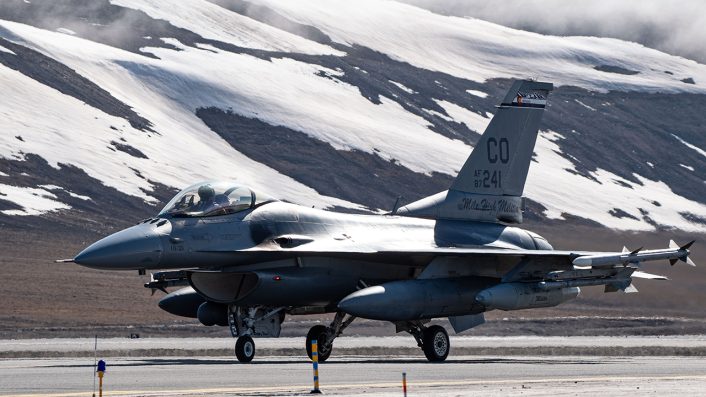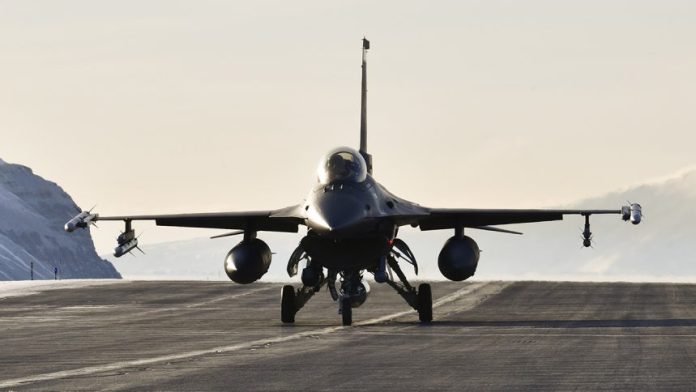Tensions in the Arctic are escalating, and the recent deployment of an F-16 fighter jet to Greenland signals a growing military presence in the region. US Secretary of State Marco Rubio recently reported Russian military aircraft activity near Arctic airspace. Although these aircraft did not breach the air defence identification zones (ADIZ) of Alaska or Canada, the presence of these planes prompted a swift response from the US and its allies.
Though these Russian aircraft did not enter the air defence identification zones (ADIZ) of Alaska or Canada, their proximity prompted action. Two CF-18s from the Royal Canadian Air Force, two USAF F-35As, an E-3 AWACS, and a KC-135 tanker were sent to monitor the situation. NORAD stated that it did not consider the Russian activity to be a direct threat.
However, the swift deployment of two F-16s to Greenland has drawn attention. The official reason given was to strengthen NORAD’s Arctic presence, but the move clearly has strategic significance.
The geopolitical importance of the Arctic
The Arctic is warming, both literally and geopolitically. As the ice melts, new shipping routes, mineral resources, and strategic locations become accessible. China has already recognised the potential of this region and has been investing heavily in Greenland’s infrastructure and mining sectors. These developments have raised concerns in Washington.
When US President Trump first suggested purchasing Greenland, it was dismissed as an unlikely idea. However, with the shifting political landscape, this idea has gained traction. Recently, tensions rose between Trump and Danish Prime Minister Mette Frederiksen, and the possibility of economic pressure or sanctions has been discussed.
Denmark faces limitations in securing Greenland’s vast territory. Even with plans to acquire thirty-seven F-35As, it is clear that Denmark cannot fully dominate the Arctic airspace. As a result, the US is stepping in to fill this gap.

Greenland as a key strategic location
On 30th January, Marco Rubio emphasised Greenland’s role in US national security. Speaking on SiriusXM radio, he stated: “President Trump has made it clear that he wants to buy Greenland. This isn’t just about land—it’s about power. This is a national security issue.”
Rubio also warned of China’s growing influence in Greenland: “If we don’t act, we lose.”
While China has not yet responded, the situation is becoming more complex. The US deployment of F-16s to Greenland is not merely a routine operation. It signals a broader strategic effort to maintain influence over the Arctic region.
Why F-16 jets were deployed to Greenland
The decision to send F-16s to Greenland was driven by several factors. The F-16 is a versatile and cost-effective fighter that can perform various roles in the Arctic. Its speed, range, and adaptability make it well-suited for the region’s operational needs.
Greenland’s vast, remote landscape presents challenges in maintaining air superiority. The F-16 is more cost-efficient compared to more advanced fighters like the F-35, allowing for sustained operations with less logistical strain.

The F-16 also benefits from aerial refuelling, extending its range over the long distances between bases. This is crucial in a region with limited infrastructure.
The harsh Arctic conditions require aircraft capable of handling extreme weather. The F-16’s robust design and ease of maintenance make it ideal for such environments. Unlike larger, more complex aircraft, it requires less support, allowing for quick turnarounds and flexible basing options.
From a strategic perspective, the F-16’s deployment is a clear signal of US commitment to Arctic security. It provides a credible deterrent against potential adversaries without the provocation of permanently stationing more advanced assets like the F-35. The F-16 can easily integrate with NATO and NORAD forces, making it effective in joint operations.
Greenland’s growing strategic importance
Greenland’s strategic significance lies in its geographic location, vast natural resources, and its role in global power competition. For the US, Greenland serves as a vital base for monitoring Russian and Chinese activities in the region.
Thule Air Base, located in Greenland, plays a critical role in missile warning, space surveillance, and Arctic air operations. As sea routes in the Arctic become more accessible due to climate change, Greenland’s strategic importance will only increase.
Controlling Greenland’s access allows the US to maintain a dominant position in the Arctic and prevent adversarial encroachment.
Challenges for denmark and NATO
Denmark, as Greenland’s governing country, faces the challenge of securing its vast territory with limited military resources. While Denmark is committed to NATO obligations, it cannot defend Greenland alone. This reliance on US military support is essential for regional security.
Domestically, Denmark must balance Greenlandic autonomy with NATO commitments and EU priorities. Greenland’s growing geopolitical importance has led to increased defence spending, but Denmark still needs US support to ensure security.
Russia and China’s interests in Greenland
Russia views the Arctic as a key area for military power projection. The Kremlin has expanded its Arctic military presence, reactivating Soviet-era bases and increasing submarine patrols. While Russia does not directly contest Greenland, its proximity to critical Russian infrastructure makes it important for surveillance and deterrence.
China, meanwhile, focuses on economic influence. Beijing has invested in Greenland’s infrastructure, mining operations, and research initiatives. While China does not have a direct military presence in the region, its long-term strategy could involve dual-use infrastructure to support future military operations.
Greenland’s resources, particularly its rare-earth mineral deposits, are crucial for modern technologies, making the island an attractive target for Chinese investment.
The future of Greenland in global security
As geopolitical tensions in the Arctic continue to rise, Greenland’s strategic importance will only increase. The US seeks to maintain dominance in the region, while Denmark faces the challenge of balancing sovereignty with military limitations. Russia is keen to expand its Arctic military presence, and China aims to expand its economic and strategic reach.

The future of Greenland in global security will depend on how these competing interests play out. Resource control, military presence, and geopolitical influence will continue to shape the Arctic landscape in the coming years.
